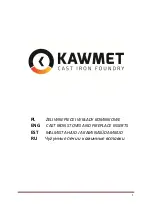
8.6. Troubleshooting the Greenfire pellet stove
Compared to a conventional wood-burning stove, a pellet stove features a lot more mechanical and
electronic systems. As a result, a number of problems may arise that can have a negative influence
on both ignition and combustion.
It is a good idea to check through these troubleshooting guidelines before calling a service
technician and/or submitting a complaint.
8.6.1. Troubleshooting
Before ignition, check that:
a) The cast iron top and pellet tank seal tightly.
b) The cast iron cover on the top seals tightly with the top itself.
c) The burn pot is sitting tightly against the lower section, and that there is no ash or pellet
residue between the burn pot and the pipe in which it is fitted.
d) The seal on the ash pan is intact, and that the pan closes tightly against the stove.
e) The seal on the door to the combustion chamber is intact, and all edges of the door sit tightly
against the chamber.
f) The oven has been thoroughly cleaned as described in the cleaning manual. Please note that
section 2.2 on page 4 is particularly important, as a lot of ash may build up here and block the
passage of the smoke.
If there are faults in one or more of the areas mentioned above, rectify the fault and then test run
the stove.
Detailed explanations of sections 1.1 through 1.6
Sections 1.1 and 1.2
If the seal between these parts is not tight, unwanted air will be drawn
through the pellet tank and into the stove. This air will not contribute to the combustion process
–
rather it will reduce the volume of air used for combustion. The effect on/diminishing of the
combustion process will be greater the fewer pellets are left in the tank, because the air resistance
through the tank falls in step with the quantity of pellets in it.
Section 1.3
It is important that the burn pot is correctly positioned and forms a tight seal with the
stove, because the combustion air will otherwise flow around the pot. This will result in poorer
combustion and diminish the effect of the cleaning function. The diminishing effect on the
combustion will increase proportionately to the soiling of the burn pot.
Sections 1.4 and 1.5
It is essential to keep the ash pan and the seal on the door tight because
even a small leak will have serious consequences on the combustion. If the ash pan is even slightly
open, the stove will hardly be able to burn any fuel at all, and will quickly become dirty.
Section 1.6
Section 2.2 on page 4 is particularly important because so much ash can build up here
that it blocks the draught to the chimney, which will result in a poor supply of combustion air. If this
section is not cleaned regularly as described in these instructions, it will also result in faster soiling
of the interior ducts in the stove and require more regular service visits involving dismantling the
stove and cleaning the insides of the pipes, ducts and chambers.







































